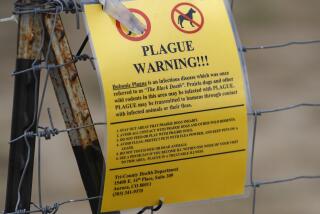Questions and answers about anthrax
- Share via
WASHINGTON — Anthrax is becoming a household word, yet there are many questions about how it is contracted and treated and how people are tested for it.
Q: What is anthrax?
A: Typically a disease of grazing animals, it is contracted from exposure to spores of Bacillus anthracis, a bacterium. Dating back as early as the time of Moses, anthrax gets its name from the Greek word for coal because the scab left on the skin is black.
Q: Is there a vaccine that can be given to protect people against anthrax?
A: Yes, but vaccinations are only given to people who may come into contact with the bacterium, including those in the military and people who work in labs or with farm animals.
Q: I don’t have any reason to believe I’ve been exposed to anthrax but I’m still worried. Should I get tested?
A: No. People without symptoms are given antibiotics preventively only if they were in the area where anthrax was present. Nasal swabs can show that someone was exposed, but a negative swab does not mean someone was not exposed. These tests are administered mostly to help authorities determine a pattern of exposure, not to diagnose individuals.
Q: What if I’m feeling sick?
A: See a doctor. Tests will show if you are actually infected with the disease.
Q: Can someone who’s already infected still be successfully treated?
A: It depends on how the anthrax was contracted.If someone contracts inhaled anthrax, it may be too late to successfully treat the disease by the time symptoms appear. This is why a man in Florida died.
But this type of anthrax is very rare, partly because it’s very unusual for clumps of anthrax spores to be small enough to go down one’s respiratory track and lodge deep in the lungs.
Most anthrax cases infect the skin, and these cases are highly curable with antibiotics even after the symptoms appear.
Anthrax also can be digested, but this is extremely rare.
Q: What are the symptoms of skin anthrax?
A: It starts with a painless blister that is red around the edges. A day or two later, this becomes a black open sore, which dries up to leave a black scab, which falls off after a week or two.
Q: What are the symptoms of inhaled anthrax?
A: At first, they seem like a cold or flu: fever, ache and nonproductive cough. Plummeting blood pressure, swelling, hemorrhaging and other catastrophic symptoms soon follow.
Q: Why not take antibiotics just to be safe?
A: People who take antibiotics when they are not needed may help the bacteria become resistant to that drug. Later, that bacteria would not respond to treatment by the same drug when others are actually infected. Also, these drugs can have serious side effects, such as an irregular heart beat or digestive problems.
Q: Should I stock up on antibiotics just in case I need them later?
A: No. Federal officials say there are plenty available, and they plan to stockpile even more. They also are advising doctors against prescribing antibiotics to people who do not need them.
Q: Did the anthrax in Florida, New York and Washington come from the same place?
A: This is one of the questions that law enforcement is trying to answer. Preliminary tests indicate that the anthrax found at NBC in New York and in Florida were the same strain, meaning they came from the same genetic family. This suggests -- but does not prove -- that the same person may have mailed both letters. Authorities haven’t said yet what strain the Washington anthrax came from.
Q: Do authorities know where the anthrax came from?
A: If they do, they aren’t saying.
Q: Some senators have said that the Washington anthrax was particularly potent. Was it?
A: Health authorities say “potent” is the wrong term to describe it. The type of anthrax sent to Senate Majority Leader Tom Daschle responds to all major antibiotics and therefore is not considered more dangerous than anthrax found elsewhere.
What isn’t clear, though, is whether the person who sent the Daschle letter tried to manipulate the anthrax -- or “weaponize” it -- so it would spread through the air more easily and be more easily inhaled and therefore more lethal.
More to Read
Sign up for Essential California
The most important California stories and recommendations in your inbox every morning.
You may occasionally receive promotional content from the Los Angeles Times.








